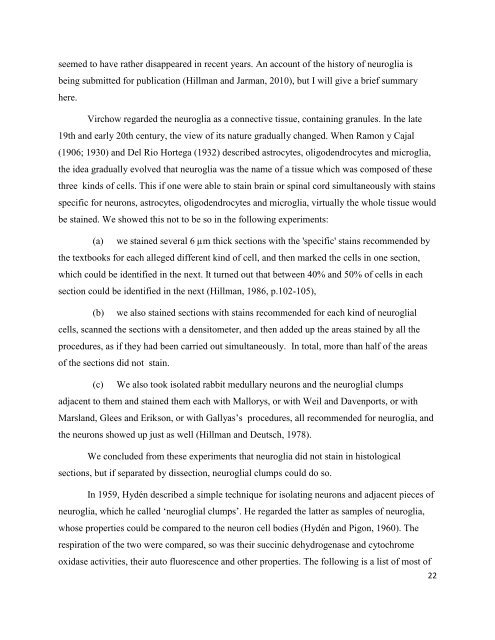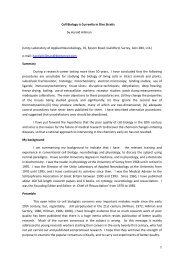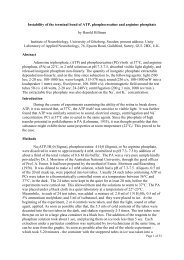download PDF version - Dr Harold Hillman
download PDF version - Dr Harold Hillman
download PDF version - Dr Harold Hillman
- No tags were found...
You also want an ePaper? Increase the reach of your titles
YUMPU automatically turns print PDFs into web optimized ePapers that Google loves.
seemed to have rather disappeared in recent years. An account of the history of neuroglia isbeing submitted for publication (<strong>Hillman</strong> and Jarman, 2010), but I will give a brief summaryhere.Virchow regarded the neuroglia as a connective tissue, containing granules. In the late19th and early 20th century, the view of its nature gradually changed. When Ramon y Cajal(1906; 1930) and Del Rio Hortega (1932) described astrocytes, oligodendrocytes and microglia,the idea gradually evolved that neuroglia was the name of a tissue which was composed of thesethree kinds of cells. This if one were able to stain brain or spinal cord simultaneously with stainsspecific for neurons, astrocytes, oligodendrocytes and microglia, virtually the whole tissue wouldbe stained. We showed this not to be so in the following experiments:(a) we stained several 6 µm thick sections with the 'specific' stains recommended bythe textbooks for each alleged different kind of cell, and then marked the cells in one section,which could be identified in the next. It turned out that between 40% and 50% of cells in eachsection could be identified in the next (<strong>Hillman</strong>, 1986, p.102-105),(b) we also stained sections with stains recommended for each kind of neuroglialcells, scanned the sections with a densitometer, and then added up the areas stained by all theprocedures, as if they had been carried out simultaneously. In total, more than half of the areasof the sections did not stain.(c) We also took isolated rabbit medullary neurons and the neuroglial clumpsadjacent to them and stained them each with Mallorys, or with Weil and Davenports, or withMarsland, Glees and Erikson, or with Gallyas‟s procedures, all recommended for neuroglia, andthe neurons showed up just as well (<strong>Hillman</strong> and Deutsch, 1978).We concluded from these experiments that neuroglia did not stain in histologicalsections, but if separated by dissection, neuroglial clumps could do so.In 1959, Hydén described a simple technique for isolating neurons and adjacent pieces ofneuroglia, which he called „neuroglial clumps‟. He regarded the latter as samples of neuroglia,whose properties could be compared to the neuron cell bodies (Hydén and Pigon, 1960). Therespiration of the two were compared, so was their succinic dehydrogenase and cytochromeoxidase activities, their auto fluorescence and other properties. The following is a list of most of22




